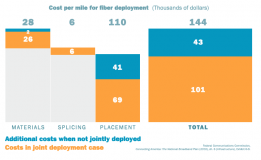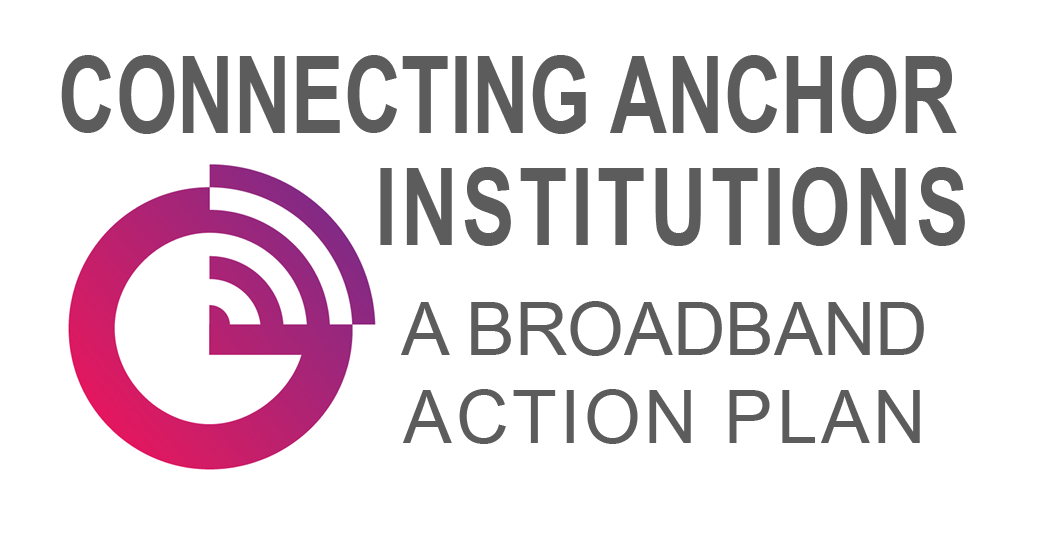Broadband Infrastructure Policy and Community Anchor Institutions
Summary
Numerous studies document that rights-of-way management policies can dramatically impact the cost and speed of broadband deployment. This paper recommends “dig once” policies, installing empty conduit for competitive providers, permitting CAIs to use dark fiber, standardizing lease agreements for all providers, implementing asset inventory databases, improving wireless tower siting policies, and simplifying rights-of-way approval processes.
Read Full Policy PaperRecommendations for Action
Dig Once, Rights-of-Way, and Conduit Policies
- Federal, state, and local governments should adopt binding and enforceable “dig once” policies that will lower the cost of broadband deployment by requiring coordination between government and the private sector on broadband construction and upgrades.
- Infrastructure projects and development that involve public rights-of-way, or are built on public lands, or are subsidized with universal service funds, should include installation of empty conduit that can be made available to commercial service providers.
- Federal and state governments should establish common and uniform lease agreements, rates, and terms of access to rights-of-way, public lands and facilities for broadband network construction and upgrades.
- As part of community planning and community anchor institution connectivity initiatives, state and local governments should review rights-of-way management policies, including fees charged, in order to streamline approval and lower the costs of that connectivity. Community anchor institution representatives should be included in this assessment and review.
- In negotiating rights-of-way arrangements with broadband service providers, local policymakers should ensure that community anchor institutions are offered service at appropriate and affordable rates, terms, and conditions.
- In using or leasing empty fiber optic conduit, government should ensure that community anchor institutions have the ability to lease or obtain dark or lit fiber services through that conduit.
Effective Pole Attachment Management and Regulation
- Federal, state and local authorities responsible for resolving pole attachment disputes between providers and utilities should do so quickly, effectively, and in a pro-competitive manner.
- Policymakers should revise pole attachment rules so that they: (a) include all utility poles, ducts, and conduit; (b) provide clear, consistent, uniform, and low rental and make-ready rates for attachments for all broadband, cable, and telecommunications providers; (c) establish clear timelines and terms of access; and (d) include enforceable commitments.
Asset and Property Management
- The Federal Government should implement the federal asset inventory database recommended by the Broadband Opportunity Council (BOC).
- State and local governments should implement similar asset inventory databases and should, as recommended by the BOC, work with federal authorities to develop a common platform for those databases.
- Community anchor institution sites and facilities should be included in all community asset inventory databases.
Wireless Tower Siting Policies
- State and local governments should move quickly to fully implement Section 6409(a) of the Middle Class Tax Relief and Job Creation Act of 2012, which expedites wireless tower siting policies.
Examples/Case Studies
Graphs and Data
Additional Resources
- U.S. Department of Agriculture and U.S. Department of Commerce, Broadband Opportunity Council Report and Recommendations, August 20, 2015. To make sure that the Federal government does everything within its power to support broadband deployment and adoption, President Barack Obama created the Broadband Opportunity Council and tasked it to produce specific recommendations to increase broadband deployment, competition and adoption through executive actions within the scope of existing agency programs, missions and budgets. https://www.whitehouse.gov/sites/default/files/broadband_opportunity_council_report_final.pdf
- Broadband Deployment on Federal Property Working Group, Implementing Executive Order 13616: Progress on Accelerating Broadband Infrastructure Deployment, August 2013. President Obama issued an Executive Order to facilitate wired and wireless broadband infrastructure deployment on Federal lands, buildings, and rights-of-way, federally assisted highways, and tribal and individual Indian trust lands, particularly in underserved communities. The E.O. established and charged the Broadband Deployment on Federal Property Working Group with ensuring a coordinated approach in implementing agency procedures, requirements, and policies related to these topics. https://www.whitehouse.gov/sites/default/files/microsites/ostp/broadband_eo_implementation.pdf
- CTC Technology & Energy, Gigabit Communities: Technical Strategies for Facilitating Public or Private Broadband Construction in Your Community, 2014. The key ingredient for private investment in gigabit deployment is true partnership. It is not enough for the locality to undertake all these steps if there is no willing and able private partner—one that is committed to building next-generation infrastructure rather than simply reducing costs on existing legacy networks. http://www.ctcnet.us/wp-content/uploads/2014/01/GigabitCommunities.pdf
- Federal Communications Commission, Connecting America: The National Broadband Plan, Chapter 6 (Infrastructure), March 2010. The plan recommended that 1) government should take steps to improve utilization of existing infrastructure to ensure that network providers have easier access to poles, conduits, ducts and rights-of-way and 2) the federal government should foster further infrastructure deployment by facilitating the placement of communications infrastructure on federally managed property and enacting dig once legislation. https://transition.fcc.gov/national-broadband-plan/national-broadband-plan.pdf
- Federal Highway Administration, U.S. Department of Transportation, Successful Practices of Broadband Deployment in Highway Rights- of-Way: Summary Paper, May 2013. This paper presents an overview of successful broadband deployment practices in highway rights-of-way, with a focus on the installation of underground fiber optic facilities and related efforts to minimize excavation of the roadway. https://www.fhwa.dot.gov/policy/otps/successprac.pdf
- Office of Transportation Policy Studies, Federal Highway Administration, U.S. Department of Transportation, Policy Brief: Minimizing Excavation through Coordination, October 2013. What is dig once and what are the policy implications? https://www.fhwa.dot.gov/policy/otps/policy_brief_dig_once.pdf
- Tim Feran, “Map could help Columbus ramp up Broadband,” Columbus Dispatch, March 29, 2015. Connected Nation Exchange will develop a map for the city that shows where Columbus, OH, owns properties that can be used to expand broadband networks. Those properties include buildings, rooftops, towers, utility poles, signs, water tanks and existing fiber-optic lines. http://www.dispatch.com/content/stories/business/2015/03/29/1-map-could-help-city-ramp-up-broadband.html
- Christopher Mitchell, “Mesa’s Focus on Dig Once and Fiber Leases Pays Off,” Community Broadband Networks, February 24, 2015. Mesa, AZ, is one of the largest communities in the nation to benefit from the city taking a role in ensuring conduit and fiber are available throughout the area. https://muninetworks.org/content/mesas-focus-dig-once-and-fiber-leases-pays-community-broadband-bits-podcast-139
- Connect Every Acre, Iowa House File 655, June 22, 2015. Legislation aimed at better coordinating of broadband access in targeted areas of the state. https://www.legis.iowa.gov/legislation/BillBook?ga=86&ba=HF655
- National Association of Counties, National League of Cities, and National Association of Telecommunications Officers and Advisors, Wireless Facility Siting: Model Chapter Implementing Section 6409(a), March 5, 2015. A guide to help: 1) develop a model ordinance and application for reviewing eligible facilities requests under Section 6409(a); 2) distribute wireless siting best practices; 3) create a checklist that local government officials can use to help streamline the review process; and 4) hold webinars regarding the application process. http://www.naco.org/sites/default/files/Model-Ord-NACo.pdf
- Levin, Blair and Denise Linn. The Next Generation Network Connectivity Handbook: A Guide for Community Leaders Seeking Affordable, Abundant Bandwidth Benton Foundation, July 2015. A comprehensive guide for communities who want better broadband for their residents and businesses based on the experience of 25 Gig.U communities. http://www.gig-u.org/cms/assets/uploads/2015/07/Val-NexGen_design_7.9_v2.pdf
- Google Fiber City Checklist, February 2014. A collection of best practices recommended by the Fiber to the Home Council, Gig.U and the U.S. Conference of Mayors that can help any fiber provider or city that is thinking of building a new network. https://fiber.storage.googleapis.com/legal/googlefibercitychecklist2-24-14.pdf
About the Author
Tom Koutsky serves as Chief Policy Counsel for Connected Nation. Tom provides vision and leadership for Connected Nation’s research and policy initiatives. Tom joined Connected Nation from the Federal Communications Commission where he served as a Senior Advisor to the team that wrote the first U.S. National Broadband Plan. Tom focused on policy recommendations related to network infrastructure, the law and economics of middle-mile connectivity, wholesale competition rules, and universal service and access charge reform.
Policy Papers
Latest Updates From Twitter
Action Plan Authors
Amelia Bryne
Kelleigh Cole
Joanne Hovis
Tom Koutsky
Blair Levin
Christine Mullins
Angela Siefer
Gina Spade
John Windhausen
Steering Committee
Larra Clark, American Library Association
Adrianne Furniss, Benton Foundation
Kevin Taglang, Benton Foundation
Bob Collie, ENA
Lil Kellogg, ENA
Rex Miller, ENA
Susannah Spellman, Internet2/USUCAN











 Download Full Action Plan
Download Full Action Plan